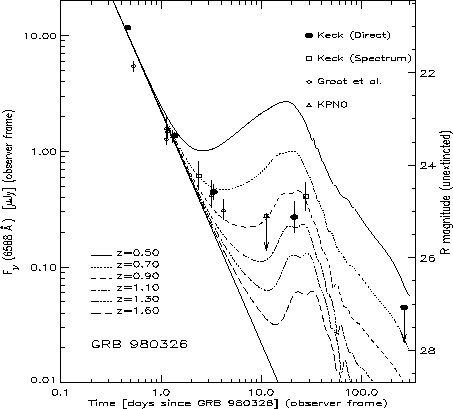



Next: GRB Energetics
Up: The Afterglow Emission
Previous: Host Galaxies and Redshifts
Contents
The very first work that considered the idea of a connection between
the GRBs and the Supernovae (SNs) was by [Colgate, 1968], [Colgate, 1974].
About thirty years later this link seems to exist.
As already anticipated, the case of GRB980425, probably associated with
a peculiar type Ic supernova, SN 1998bw ([Galama et al., 1998]) is the
most important to date, although the actual identification of the SN with
the X-ray afterglow remains somewhat uncertain. An interesting indication
in favour of this, is that the radio emitting shell in SN 1998bw is
expanding at relativistic velocities,  ([Kulkarni et al., 2000a]),
previously never observed before in a SN.
If this association is real, GRB980425 is certainly not a typical GRB:
in this case, the energy budget of the gamma-ray emission is
([Kulkarni et al., 2000a]),
previously never observed before in a SN.
If this association is real, GRB980425 is certainly not a typical GRB:
in this case, the energy budget of the gamma-ray emission is  smaller than those of normal GRBs ([Galama et al., 1998]).
smaller than those of normal GRBs ([Galama et al., 1998]).
Also late-time rebrightening arguments seem to support this connection,
like in the case of GRB980326 ([Bloom et al., 1999]; see fig. ![[*]](crossref.png) ),
where the afterglow light curve might be affected by the light curve
of an underlying SN. Also in the case of GRB970228 similar arguments seem
to work.
Nevertheless, several GRB afterglows do not exhibit such re-brightening,
albeit detectable in principle.
),
where the afterglow light curve might be affected by the light curve
of an underlying SN. Also in the case of GRB970228 similar arguments seem
to work.
Nevertheless, several GRB afterglows do not exhibit such re-brightening,
albeit detectable in principle.
Figure:
Rebrightening of the GRB980326 optical afterglow: it might be
connected with an underlying SN. Here the R-band light curve has been fitted
with an initial power law decay plus a SN Ic light curve for the redshift
range  . The best-fit redshift occurs at
. The best-fit redshift occurs at  and seems
consistent with the observed spectrum (from [Bloom et al., 1999]).
and seems
consistent with the observed spectrum (from [Bloom et al., 1999]).
 |




Next: GRB Energetics
Up: The Afterglow Emission
Previous: Host Galaxies and Redshifts
Contents
Cristiano Guidorzi
2003-07-31
![[*]](crossref.png) ),
where the afterglow light curve might be affected by the light curve
of an underlying SN. Also in the case of GRB970228 similar arguments seem
to work.
Nevertheless, several GRB afterglows do not exhibit such re-brightening,
albeit detectable in principle.
),
where the afterglow light curve might be affected by the light curve
of an underlying SN. Also in the case of GRB970228 similar arguments seem
to work.
Nevertheless, several GRB afterglows do not exhibit such re-brightening,
albeit detectable in principle.
